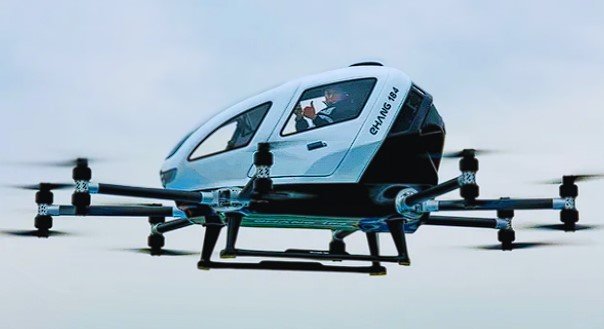China Approves Mass Production of Autonomous Flying Taxis for 2025 Commercial Flights

The EHang EH216-S is the first eVTOL (electric vertical takeoff and landing) vehicle ready for mass production. This technology could pave the way for autonomous flying taxis and revolutionize urban transportation globally.
The EHang EH216-S autonomous flying taxi represents a groundbreaking achievement as the world’s first eVTOL (electric vertical takeoff and landing) vehicle to receive production certification in China, signaling a major step towards the commercialization of autonomous flying taxis.
EHang’s milestone signifies significant progress in eVTOL technology, transitioning from prototypes to mass-produced vehicles for real-world applications. Huazhi Hu, CEO of EHang, highlighted the vision of introducing safe and reliable pilotless eVTOL aircraft to provide autonomous and eco-friendly air mobility services globally.
The production certificate granted by the Civil Aviation Administration of China (CAAC) enables EHang to commence mass manufacturing of flying cars, encompassing the entire production process from raw material sourcing and supply chain management to quality control, testing, and after-sales support.
The EHang EH216-S, first announced in 2018, is a compact, fully-electric VTOL craft featuring a carbon fiber fuselage and 16 propellers powered by 16 motors. With a cruise speed of 62 mph (100 km/h) and a maximum altitude of around 10,000 feet (3,000 meters), this vehicle is designed for passenger transport with a capacity for two occupants and an autonomous driving system eliminating the need for a pilot. EHang has extensively tested the EH216-S through crewed and uncrewed flights, building upon its previous model, the EHang 184 “passenger drone” introduced in 2016.
EHang envisions the EH216-S serving various purposes, including air taxi services, aerial tourism, airport shuttles, and cross-island transportation.
The mass production approval of the EH216-S is a significant step towards realizing unmanned eVTOLs and similar aircraft for commercial use. This achievement positions China as a leader in deploying flying taxis as a viable transportation service.
Looking ahead, China’s Green Aviation Manufacturing Development Outline (2023-2035) outlines a roadmap towards piloted eVTOL operations by 2025 and fully autonomous services by 2035, emphasizing the importance of establishing practical regulations and insurance frameworks for flying cars.
In contrast, the U.S. Advanced Air Mobility (AAM) Implementation Plan targets 2028 for the commercial deployment of eVTOLs, focusing on regulatory and certification processes to ensure safe manufacturing and operation.
With China’s progress in certifying and potentially deploying eVTOLs at a commercial scale, it is poised to lead the global development of autonomous flying taxis, potentially advancing ahead of the U.S. in this transformative transportation sector.








